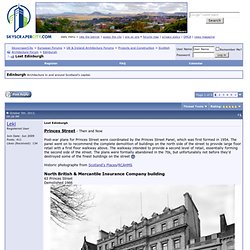

Reinstate the R W Forsyth sphere. The R W Forsyth sphere has been a landmark feature of the Princes Street skyline in Edinburgh for well over a century.

R W Forsyth was a prominent Edinburgh department store which traded from 1906 until 1981. The building itself was designed by acclaimed architect J.J. Burnet and is a unique and fine example of Edwardian baroque in Edinburgh. R W Forsyth's Edinburgh store was also the first fully steel framed structure in Scotland. The armillary sphere, which has been missing since March 2012 when it was taken away for repairs, is an integral feature of this beautiful Category A listed building.
The repairs were set to take just six weeks, but nearly three years have now passed since the iconic sphere's removal. Lost Edinburgh. Princes Street - Then and Now.

Conservation area and listed buildings map - Conservation areas. Historic houses & palaces Edinburgh and the Lothians. Edinburgh World Heritage - Home. A guide to the architecture and design of Edinburgh - Edinburgh’s architecture from medieval tenements to the ultra-modern. Edinburgh’s architecture continues to inspire, from the medieval tenements of the Old Town to the ultra-modern Scottish Parliament Should you happen past Enric Miralles’ Scottish Parliament building at the foot of the Royal Mile and hear raised voices from a group of otherwise peaceful-looking types, don’t be surprised.

It’ll just be yet another architectural tour that has descended into debate over the controversial building, which has been a talking (or should that be shouting) point, ever since Miralles first put pen to paper and sketched his idea for the parliament. The building, which eventually finished up massively over budget, could be described as the architectural equivalent of Marmite, so clear is the divide between the citizens and visitors who love it or loathe it. One thing is for sure, though: you can’t ignore it.
This is a building that demands attention. ‘My tours end at the parliament, and often in a row,’ says Isabelle Lomholt of www.edinburgh architecture.co.uk. Edinburgh News, Buildings, Property, Edinburgh Building News, Scotland. William J Hay - Small leaflet - Royal Mile Map. Edinburgh town walls. There have been several town walls around Edinburgh, Scotland, since the 12th century.

Some form of wall probably existed from the foundation of the royal burgh in around 1125, though the first building is recorded in the mid-15th century, when the King's Wall was constructed. In the 16th century the more extensive Flodden Wall was erected, following the Scots' defeat at the Battle of Flodden Field in 1513. This was extended by the Telfer Wall in the early 17th century. The walls had a number of gates, known as ports, the most important being the Netherbow Port, which stood halfway down the Royal Mile. This gave access from the Canongate which was, at that time, a separate burgh. The walls never proved very successful as defensive structures, and were easily breached on more than one occasion.
Background[edit] Edinburgh was formally established as a royal burgh by King David I of Scotland around 1125. King's Wall[edit] Walling in Tweeddale Court, thought to be the King's Wall. RBS plan to share historic Edinburgh HQ. American aircraft millionaire donates historic Royal Mile property to nation - Edinburgh. Lost Edinburgh: The Luckenbooths. UP UNTIL the early 19th century the flow of traffic on Edinburgh’s busy High Street was restricted to just a few metres thanks to a group of medieval buildings known as the Luckenbooths.

The Luckenbooths were a row of irregular-sized tenements and shops stretching along the north face of St Giles’ Kirk on the High Street. They sprang up in the mid-15th century primarily to appease the rising number of skilled artisans and speciality traders such as silversmiths and goldsmiths who demanded a more formal, permanent base to hawk their wares than the usual market stall method. ‘Buith-Raw’ The first building was constructed in 1440, and was a two-storey timber fronted house with an open merchant area at ground level. This initial house and the seven or eight others which followed it soon came to be known as the ‘Buith-Raw’ (Booth Row) and they varied greatly in height and character. Famous traders. Ten castles to visit in and around Edinburgh.
The Maltings, , Bourne, Lincs.

PE10 9PH Tel:+44 (0)1778 391000 • Fax: +44 (0)1778 421706 Last Updated: 10th May 2012 This page (together with the documents referred to on it) tells you the terms on which you may use and access our website whether as a guest or a registered user. Please read these terms of use and acceptable use policy (Terms) carefully before you start to use the Site. Our Site is a site operated by Warners Group Publications Plc ("We").
We are a public limited company. Access to our Site is permitted on a temporary basis, and we reserve the right to withdraw or amend the service we provide on our Site without notice (see below). From time to time, we may restrict access to some parts of our Site, or our entire Site, to users who have registered with us. When using our Site, you must comply with the provisions of our acceptable use policy as set out in these Terms. You are responsible for making all arrangements necessary for you to have access to our Site. Leith Walk botanical cottage, demolished and risen again — Flother. Before I left Edinburgh six months ago I lived in Broughton, just off the top of Leith Walk.

It was originally a village, one of the many you’ll find chipped away and consumed by the city as it grows ever larger. As with all Edinburgh the area has plenty of history for those who know where to look. Iceland’s national anthem was written in a house in London Street during the decades its people fought for a republic. Within five minutes’ walk from my house you could wander along East London Street, up Annandale Street, turn onto Leith Walk, and — if you knew where to look — you could see the first house built for the keeper of the city’s botanical garden.
Botanic Cottage to be rebuilt using same stones in Edinburgh. 16 August 2012Last updated at 11:50 ET Botanic Cottage was at the Royal Botanic Garden Edinburgh site in Leith Walk An 18 Century cottage in Edinburgh which was painstakingly removed stone by numbered stone is to be put back together less than two miles away.

Botanic Cottage was the gateway to the previous Royal Botanic Garden Edinburgh (RBGE) site in Leith Walk between 1764 to 1821. When RBGE transferred the Leith Walk plant collections to Inverleith, in 1820, the cottage fell into disrepair. It then faced demolition in 2008 before campaigners saved it. Friends of Hopetoun Gardens, saved the building and a small grant was secured to take it down stone by stone. Historical value. Scottish City Architecture - Introduction. Glasgow's other architectural hero, Charles Rennie Mackintosh, has not been forgotten.

His early 20th century modernism has left a remarkable legacy to the city in the fields of both architecture and design. The novel architectural ideas of Mackintosh have been highlighted throughout this site. I have included drawings of the Glasgow Herald Building, Glasgow School of Art, Willow Tearooms (above), Queen's Cross Church and Scotland Street School. Edinburgh Architecture - The Royal Mile. The top of the Royal Mile is dominated by Edinburgh Castle which is entered from the esplanade which was laid out as a ceremonial parade ground in 1753.

The castle consists of a collection of buildings sitting on a fortress on top of the summit of an extinct volcano. This defensive position is protected by sheer cliffs, and provides clear views over all of Edinburgh as far as the Firth of Forth. The north side of the castle sits loftily above Princes Street and its wonderful gardens. Edinburgh Castle from the esplanade The building at the very top of the drawing is the ancient Royal Palace, which houses the Stone of Destiny and Scotland’s crown jewels. Clock tower at Royal Palace, Edinburgh Castle. Old Edinburgh Landmarks - Historic Buildings. In the years leading to the end of the century the English Gothic Revival had crossed the border to become established in Scotland. Sir George Gilbert Scott was the most fashionable practitioner of the time in England, and he was asked to design Edinburgh's Episcopal Cathedral, St Mary's, in the Western New Town.
The cathedral was built between 1874 and 1879, with later embellishments. Scott had previously designed the new buildings for Glasgow University at Gilmorehill (1870) and St Mary’s Episcopal Cathedral, in Great Western Road, Glasgow (1871). Central tower and spire of St Mary's Episcopal Cathedral, Edinburgh St Mary’s is the largest ecclesiastical building in Scotland, built with a large budget of over £100,000.
Glimpses of Edinburgh - Photograph Album. Governor's House, Calton Hill, Edinburgh Old Royal High School, Edinburgh, which was fitted out for the restored Scottish Parliament prior to the failed referendum of 1st March 1979 The notice outside the former Royal High School remains even though the building was never used by the Parliament Façade of Robert Adam designed building in Charlotte Square, Edinburgh 3 bay wide fanlight in Charlotte Square Gold and copper dome on West Register House, Charlotte Square W H Playfair's St Stephen's Church in Edinburgh's New Town Fettes College, former school of UK Prime Minister, Tony Blair.
Dún Èideann: a map of Edinburgh. Architects. Scottish Parliament. Panmure House.